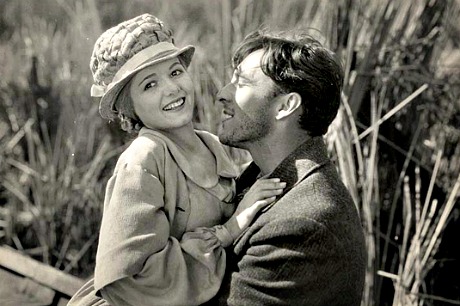The next time I visit Berlin I’m going to visit to F.W. Murnau‘s grave at Stahnsdorf cemetery. Last night I watched Fox Home Video’s new Bluray of Murnau’s Sunrise (1927), which I hadn’t seen since…I forget but sometime in the early ’80s. We all know it’s a work of pure cinematic poetry and a masterpiece of compassion and redemption, but I’d forgotten (a) how long those extended tracking shots by dps Charles Rosher and Karl Struss go on (truly groundbreaking for their day), (b) how design aspects of the amusement-park sequence resemble Fritz Lang‘s Metropolis, (c) the heartbreaking current between Janet Gaynor and George O’Brien, (d) the subdued acting styles (i.e., not entirely naturalistic but certainly leaning toward subtle by the standards of 1920s emoting), and (e) how much better Sunrise is than Murnau’s absolutely over-rated Nosferatu, which I saw for the first time not long ago and was mildly disappointed by.

Janet Gaynor, George O’Brien in F.W. Murnau’s
I’ve never liked the longer title — Sunrise: A Song of Two Humans – so apart from this mention I’m going to ignore it henceforth and for the rest of my life.
Poor Murnau went through some rough career patches after Sunrise won an Oscar in 1928 for Best “Unique and Artistic Production” (and Gaynor took the Best Actress Oscar for her work in Sunrise along with two other films). Sunrise didn’t make much money (the forebears of the fans of Saving Mr. Banks didn’t think it was entertaining enough), and his next three films — — 4 Devils (’28) and City Girl (’30) and Tabu (’31) — underperformed and/or were financially troubled.
The poor guy was killed in a car crash on his way up to Santa Barbara in March 1931, just before the premiere of Tabu. Only 11 people attended Murnau’s funeral in Stahnsdorf. Among them were Emil Jannings, Greta Garbo and Fritz Lang, who delivered the eulogy.
In my 10.30.13 review, I wrote that Nosferatu “is even stiffer and more constipated than I anticipated. I realize that I’m talking in part about my own head as well the film. My respect for Nosferatu is sincere, but from my 2013 perspective it seems as if the relic-y aspects have almost entirely overwhelmed what was once a very avant-garde and out-there (if uncredited) adaptation of Bram Stoker‘s 1897 novel of ‘Dracula.’
“Heavy-handed acting styles are inseparable from any silent melodrama, but the over-acting in Nosferatu is beyond grotesque at times. There’s a certain high-style aesthetic going on here, I realize, but the comically demented expressions used by some of the performers demand disengagement.
“The fact is that while Nosferatu is full of striking or startling images, it may be better — preferable — to process it as a series of stills (particularly those highlighting the makeup and production design aspects) rather than as a film. I used to think Todd Browning‘s Dracula (’31) was a bit creaky and dusty, but it could almost be Run Lola Run compared to Nosferatu — the new bitch on the block.”
